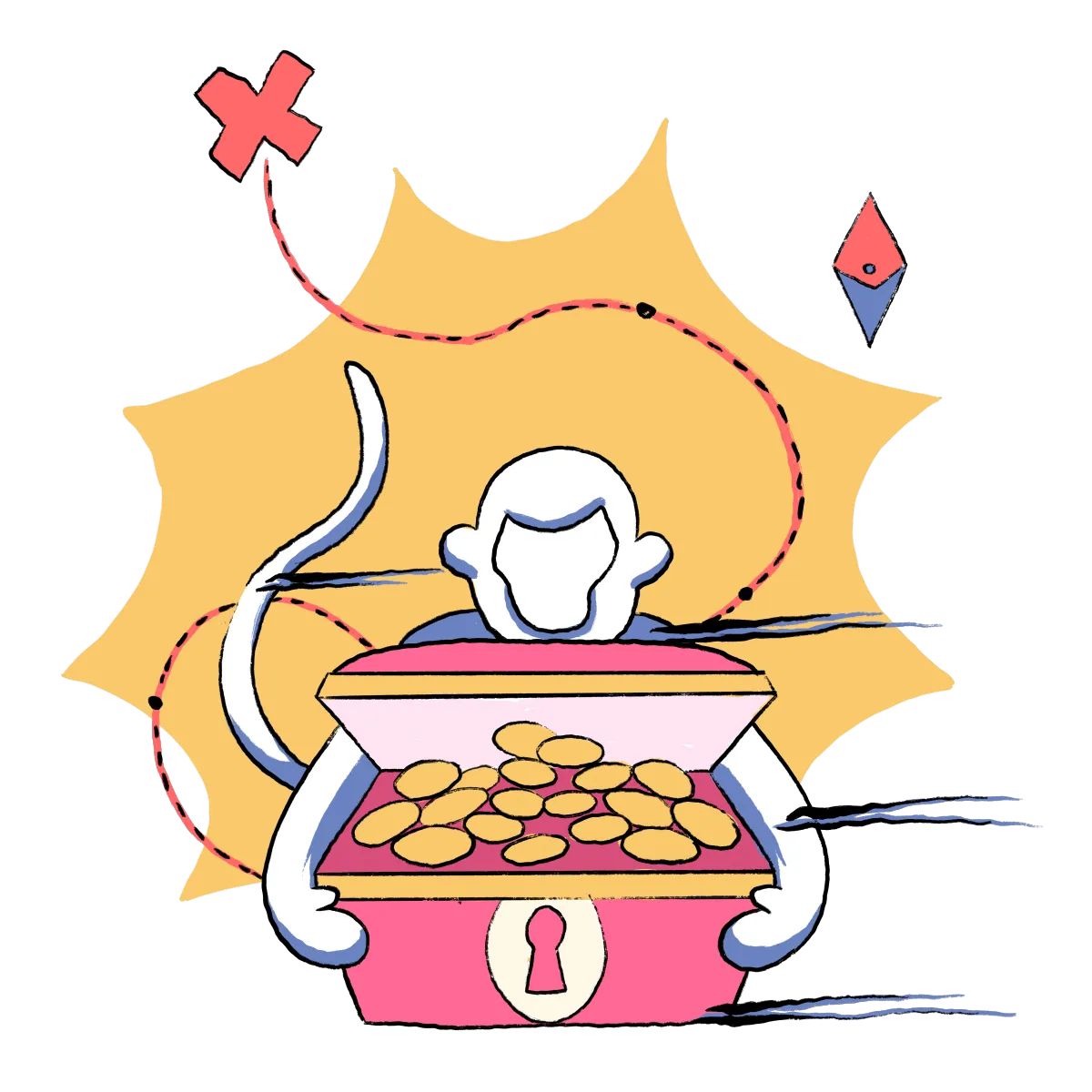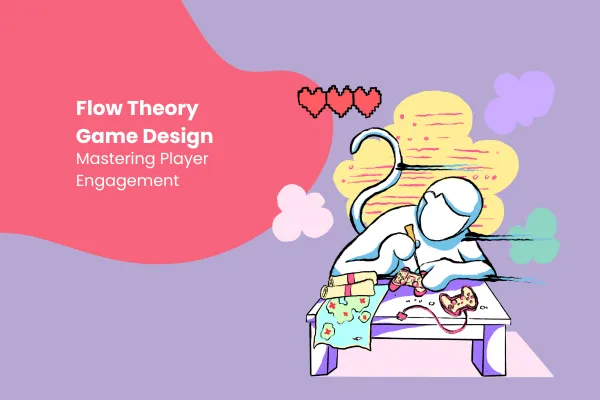Welcome to the Treasure Chest
We have hidden Golden Nuggets and secret Potions below find your relevant category and explore.


For Individuals
The section for Individual Developers and Executives or Leaders

Flow Theory Game Design: Mastering Player Engagement
Listen up, game designers! Want to create a game so immersive that players forget about the world around them? That's where Flow Theory comes into play. I've spent years diving into this concept, and trust me, it'll revolutionize your approach to game design.
Flow Theory is all about creating a state of optimal experience, where players are fully immersed and engaged. When you nail it, your game becomes an unforgettable journey that keeps players coming back for more.
Picture this: you're crafting a game that players can't stop thinking about, even when they're not playing. Sound impossible? Not with Flow Theory by your side! This powerful concept can help you design games that strike the perfect balance between challenge and reward, keeping players engaged for hours on end.
Table of Contents:
Understanding Flow Theory in Game Design
You're a game developer, so you understand the importance of crafting a captivating game design. But what separates the good from the great?
Enter flow theory - the secret sauce to designing games that keep players hooked.
Definition of Flow Theory
Flow theory, introduced by psychologist Mihaly Csikszentmihalyi, describes a state of complete absorption in an activity. When in flow, people are fully focused and engaged, losing track of time and self-consciousness.
In the context of game design, flow happens when a player's skills are perfectly matched to the game's challenges, leading to a deeply rewarding flow experience.
Mihaly Csikszentmihalyi's Contribution to Flow Theory
Picture this: you're tackling a project that pushes you to your limits, but you're loving every second of it. That's what psychologist Mihaly Csikszentmihalyi calls "flow," a phenomenon he first identified and explored in the 1970s through his pioneering research.
Csikszentmihalyi's work has been hugely influential across fields like sports, education, and of course, game design. By understanding the conditions that facilitate flow, game developers can craft experiences that fully engage players.
Elements of Flow in Game Design
So, what does it take to create flow in a game design? According to Csikszentmihalyi, flow arises when an activity has clear goals, immediate feedback, and a balance between perceived challenges and perceived skills.
In gaming terms, this means designing levels that are not too easy (leading to boredom) nor too difficult (leading to frustration). The sweet spot is a "flow channel" where the game constantly adapts to the player's growing abilities.
"The best moments in our lives are not the passive, receptive, relaxing times . . . The best moments usually occur if a person's body or mind is stretched to its limits in a voluntary effort to accomplish something difficult and worthwhile." - Mihaly Csikszentmihalyi
Games that really suck you in have a few key ingredients that make them irresistible.
A sense of control
Deep concentration
An altered sense of time
A loss of self-consciousness
Intrinsically rewarding experiences
By carefully weaving these elements into the design process, game developers can create truly captivating flow experiences that keep players coming back for more.
Applying Flow Theory to Game Design
Understanding flow theory is one thing - but how do you actually apply it to your game design? As a seasoned game developer, I've found that the key is striking the right balance across several key areas.
Balancing Challenge and Skill
The heart of flow in game design is the balance between challenge and skill. As players progress through the game, the difficulty should ramp up in perfect sync with their growing abilities.
In practice, this means carefully calibrating the learning curve, ensuring that new obstacles are introduced at just the right pace. The goal is to keep players in that sweet spot - the flow zone - where they're consistently pushed to the edge of their skills, but never over it.
Setting Clear Goals and Feedback
To maintain flow, players need to know what they're working towards and how well they're doing. Game design should incorporate clear goals and immediate feedback at every stage.
Think progress bars, score counters, and instant rewards for achievements. By providing constant, unambiguous feedback, you keep players focused and motivated.
Minimizing Distractions
Flow requires deep, uninterrupted concentration. As a game developer, it's your job to minimize any potential distractions that could break the player's focus.
Menus should be easy to navigate, annoying pop-ups avoided, and gameplay buttery smooth. The goal? Total immersion in the game world, without any distractions.
Encouraging Concentration
Achieving flow in gaming requires players to be fully immersed, mind and heart. Designers should create challenges that command complete concentration and test the limits of the gamer's abilities, encouraging a state of deep engagement.
Puzzles, complex strategies, and immersive storylines are all great tools for drawing players into a state of flow. The key is to find that perfect balance - not so simple that players get bored, but not so complex that they get overwhelmed.
Enabling Player Control
A sense of control is crucial for flow in gaming. Players need to feel that their actions have a direct, meaningful impact on the game world.
This means responsive controls, customization options, and multiple paths to success. By giving players a sense of autonomy and agency, you enable them to fully invest in the gaming experience.
Altering Perception of Time
When in flow, players often lose track of time, becoming fully immersed in the present moment. As a game developer, you can design for this altered perception of time in several ways.
Removing clocks and time limits, using dynamic pacing, and creating rich, engrossing environments can all contribute to a sense of timelessness. The goal is to make the real world fade away, leaving only the player and the game.
Examples of Games That Successfully Incorporate Flow Theory
So, what does it look like when a game really nails flow theory? Picture this: you're completely absorbed, your skills are perfectly matched to the challenges in front of you, and time just seems to disappear. That's the magic of flow, and some games have it down to a science.
Journey (2012)
This stunning indie game is a masterclass in flow design. With its minimalist gameplay, gorgeous visuals, and emotionally resonant storyline, Journey fully immerses players in a mysterious and mesmerizing world.
The game's pacing is perfectly calibrated, with challenges that gradually build in complexity as the player's skills evolve. Feedback is subtle but constant, from the shifting sands to the chiming musical cues that accompany each successful action.
Portal (2007)
Valve's groundbreaking puzzler is renowned for its ingenious game design, which keeps players engaged through a perfect balance of wit, challenge, and novelty.
Mastering the portal gun is a breeze thanks to the game's clever progression system. Each level is a stepping stone, guiding you gently from basic jumps to gravity-defying leaps. It's like learning a new language, one portal at a time.
Tetris (1984)
When it comes to iconic puzzle games, Tetris reigns supreme. It's a masterclass in creating a state of flow, where players become so immersed in the simple yet challenging gameplay that time seems to disappear.
As the blocks fall faster and faster, players enter a trance-like state of concentration, their minds fully absorbed in the challenge of fitting each piece into place. It's a testament to the power of flow that a game this simple can be so utterly engrossing.
Studying flow in gaming gives game developers a treasure trove of knowledge for making truly captivating game design. Journey's subtle positive feedback loops, Portal's perfectly balanced difficulty curve, and Tetris's ageless appeal – they all ingeniously use flow theory to craft gaming experiences you'll never forget.
Key Takeaway:
To create games that hook players, balance challenge with skill, set clear goals and feedback, minimize distractions, encourage concentration and control, and alter the perception of time. Mastering these elements can lead to immersive flow experiences in game design.
Challenges and Considerations When Applying Flow Theory
Applying flow theory in game design isn't always a walk in the park. There are some real challenges that designers face when trying to create that perfect flow state for players.
Balancing Difficulty for Diverse Player Skills
One of the biggest hurdles is balancing the game's difficulty for players with different skill levels. What might be a perfect challenge for one player could be a total cakewalk or an impossible feat for another. Game designers have to get creative to accommodate a wide range of abilities, like offering adjustable difficulty settings or using adaptive gameplay that scales with the player's performance. It's a tricky tightrope to walk, but it's essential for keeping players in that sweet spot of flow.
Maintaining Flow Throughout the Game
Keeping players in a flow state from start to finish is no small task either. Designers have to continually introduce new challenges and experiences to keep players engaged and prevent boredom from creeping in. It's all about pacing, regularly introducing fresh mechanics or obstacles, and crafting a difficulty curve that keeps players riding that "flow channel" between boredom and frustration. As a game designer myself, I've spent countless hours fine-tuning these elements to maintain that delicate balance.
Avoiding Frustration and Boredom
Speaking of frustration and boredom, they're the ultimate flow-killers in game design. A game that's too easy will have players yawning, while one that's too tough will have them rage-quitting faster than you can say "game over." Finding that Goldilocks zone is crucial for keeping players satisfied and in the zone. In my experience, extensive playtesting and user feedback are invaluable for striking that balance.
Integrating Flow with Other Game Design Elements
Flow theory doesn't exist in a vacuum - it has to play nice with all the other moving parts of game design, like story, visuals, and mechanics. Designers have to weave flow seamlessly into the overall tapestry of the game, ensuring that each element complements and enhances the others. It's a delicate dance, but when all the pieces come together just right, the result is pure gaming magic.
This study dives deep into the design principles for creating flow in educational games, which just goes to show how widely applicable and important flow theory is across all kinds of game design.
The Benefits of Incorporating Flow Theory in Game Design
So why go through all the trouble of applying flow theory in your games? Because the payoff is huge. When you nail that flow state, the benefits for both players and developers are game-changing.
Increased Player Engagement and Satisfaction
First and foremost, flow theory is the key to unlocking deep player engagement and satisfaction. When players enter that magical flow state, they become utterly absorbed in the game world, losing track of time and forgetting the outside world exists. That kind of immersion is the holy grail for game designers. It's what keeps players glued to their screens, hungry for more. And when players are that engaged, they're more likely to keep coming back for more, which is great news for player retention and game longevity.
Enhanced Learning and Skill Development
But flow isn't just about fun and games - it's also a powerful tool for learning and skill development. Games that harness flow theory effectively can help players learn and grow without even realizing it. By presenting challenges that perfectly match the player's abilities, these games create a natural learning curve that allows players to develop new skills and knowledge as they progress. It's a sneaky way to make learning feel less like a chore and more like an exciting journey of discovery.
Improved Player Retention
As I mentioned earlier, flow is fantastic for player retention. When players are fully engaged and enjoying themselves, they're much more likely to stick with a game for the long haul. That's because flow creates a powerful sense of progression and accomplishment that keeps players invested. They feel like they're constantly growing, improving, and achieving, which is an incredibly satisfying feeling that keeps them coming back for more.
Positive Word-of-Mouth and Reviews
Finally, when you create games that consistently deliver amazing flow experiences, players take notice. They'll be raving about your game to their friends, sharing clips on social media, and leaving glowing reviews on gaming sites. That kind of positive buzz is priceless for game developers. It can lead to more downloads, more sales, and a loyal fan base that eagerly awaits your next release. And as someone who's poured my heart and soul into game development, I can tell you there's no better feeling than knowing your game has made a real impact on players' lives. So there you have it - the challenges and rewards of applying flow theory in game design. It's not always easy, but when you get it right, the results are nothing short of incredible.
Key Takeaway:
Mastering flow in game design means juggling diverse player skills, keeping engagement high, and blending story with gameplay. It's tough but worth it for unmatched player immersion and satisfaction.
Conclusion
Flow Theory is a powerful tool in your game design arsenal. By understanding its principles and applying them effectively, you can create games that captivate players like never before.
The sweet spot for gaming nirvana? A delicate dance between just enough difficulty to keep things interesting and the skills to conquer any obstacle. Throw in some crystal clear goals, a dash of constructive criticism, and a distraction-free zone, and watch as your players slip into a gaming trance filled with pure, unadulterated fun.
With Flow Theory as your guide, you're equipped to design games that leave players craving more. Immerse them in worlds where challenges and skills intertwine, creating a sense of euphoria that keeps them coming back. Your dedication to crafting unforgettable experiences won't go unnoticed players will sing your praises as they get swept away in the flow of your games. So, trust in your abilities, and let your creativity guide you to design games that flow like a river.
For Studios and Organizations
Wether you're a small Indie Studio or Triple A this section is about Teams and Culture


Flow Theory Game Design: Mastering Player Engagement
Listen up, game designers! Want to create a game so immersive that players forget about the world around them? That's where Flow Theory comes into play. I've spent years diving into this concept, and trust me, it'll revolutionize your approach to game design.
Flow Theory is all about creating a state of optimal experience, where players are fully immersed and engaged. When you nail it, your game becomes an unforgettable journey that keeps players coming back for more.
Picture this: you're crafting a game that players can't stop thinking about, even when they're not playing. Sound impossible? Not with Flow Theory by your side! This powerful concept can help you design games that strike the perfect balance between challenge and reward, keeping players engaged for hours on end.
Table of Contents:
Understanding Flow Theory in Game Design
You're a game developer, so you understand the importance of crafting a captivating game design. But what separates the good from the great?
Enter flow theory - the secret sauce to designing games that keep players hooked.
Definition of Flow Theory
Flow theory, introduced by psychologist Mihaly Csikszentmihalyi, describes a state of complete absorption in an activity. When in flow, people are fully focused and engaged, losing track of time and self-consciousness.
In the context of game design, flow happens when a player's skills are perfectly matched to the game's challenges, leading to a deeply rewarding flow experience.
Mihaly Csikszentmihalyi's Contribution to Flow Theory
Picture this: you're tackling a project that pushes you to your limits, but you're loving every second of it. That's what psychologist Mihaly Csikszentmihalyi calls "flow," a phenomenon he first identified and explored in the 1970s through his pioneering research.
Csikszentmihalyi's work has been hugely influential across fields like sports, education, and of course, game design. By understanding the conditions that facilitate flow, game developers can craft experiences that fully engage players.
Elements of Flow in Game Design
So, what does it take to create flow in a game design? According to Csikszentmihalyi, flow arises when an activity has clear goals, immediate feedback, and a balance between perceived challenges and perceived skills.
In gaming terms, this means designing levels that are not too easy (leading to boredom) nor too difficult (leading to frustration). The sweet spot is a "flow channel" where the game constantly adapts to the player's growing abilities.
"The best moments in our lives are not the passive, receptive, relaxing times . . . The best moments usually occur if a person's body or mind is stretched to its limits in a voluntary effort to accomplish something difficult and worthwhile." - Mihaly Csikszentmihalyi
Games that really suck you in have a few key ingredients that make them irresistible.
A sense of control
Deep concentration
An altered sense of time
A loss of self-consciousness
Intrinsically rewarding experiences
By carefully weaving these elements into the design process, game developers can create truly captivating flow experiences that keep players coming back for more.
Applying Flow Theory to Game Design
Understanding flow theory is one thing - but how do you actually apply it to your game design? As a seasoned game developer, I've found that the key is striking the right balance across several key areas.
Balancing Challenge and Skill
The heart of flow in game design is the balance between challenge and skill. As players progress through the game, the difficulty should ramp up in perfect sync with their growing abilities.
In practice, this means carefully calibrating the learning curve, ensuring that new obstacles are introduced at just the right pace. The goal is to keep players in that sweet spot - the flow zone - where they're consistently pushed to the edge of their skills, but never over it.
Setting Clear Goals and Feedback
To maintain flow, players need to know what they're working towards and how well they're doing. Game design should incorporate clear goals and immediate feedback at every stage.
Think progress bars, score counters, and instant rewards for achievements. By providing constant, unambiguous feedback, you keep players focused and motivated.
Minimizing Distractions
Flow requires deep, uninterrupted concentration. As a game developer, it's your job to minimize any potential distractions that could break the player's focus.
Menus should be easy to navigate, annoying pop-ups avoided, and gameplay buttery smooth. The goal? Total immersion in the game world, without any distractions.
Encouraging Concentration
Achieving flow in gaming requires players to be fully immersed, mind and heart. Designers should create challenges that command complete concentration and test the limits of the gamer's abilities, encouraging a state of deep engagement.
Puzzles, complex strategies, and immersive storylines are all great tools for drawing players into a state of flow. The key is to find that perfect balance - not so simple that players get bored, but not so complex that they get overwhelmed.
Enabling Player Control
A sense of control is crucial for flow in gaming. Players need to feel that their actions have a direct, meaningful impact on the game world.
This means responsive controls, customization options, and multiple paths to success. By giving players a sense of autonomy and agency, you enable them to fully invest in the gaming experience.
Altering Perception of Time
When in flow, players often lose track of time, becoming fully immersed in the present moment. As a game developer, you can design for this altered perception of time in several ways.
Removing clocks and time limits, using dynamic pacing, and creating rich, engrossing environments can all contribute to a sense of timelessness. The goal is to make the real world fade away, leaving only the player and the game.
Examples of Games That Successfully Incorporate Flow Theory
So, what does it look like when a game really nails flow theory? Picture this: you're completely absorbed, your skills are perfectly matched to the challenges in front of you, and time just seems to disappear. That's the magic of flow, and some games have it down to a science.
Journey (2012)
This stunning indie game is a masterclass in flow design. With its minimalist gameplay, gorgeous visuals, and emotionally resonant storyline, Journey fully immerses players in a mysterious and mesmerizing world.
The game's pacing is perfectly calibrated, with challenges that gradually build in complexity as the player's skills evolve. Feedback is subtle but constant, from the shifting sands to the chiming musical cues that accompany each successful action.
Portal (2007)
Valve's groundbreaking puzzler is renowned for its ingenious game design, which keeps players engaged through a perfect balance of wit, challenge, and novelty.
Mastering the portal gun is a breeze thanks to the game's clever progression system. Each level is a stepping stone, guiding you gently from basic jumps to gravity-defying leaps. It's like learning a new language, one portal at a time.
Tetris (1984)
When it comes to iconic puzzle games, Tetris reigns supreme. It's a masterclass in creating a state of flow, where players become so immersed in the simple yet challenging gameplay that time seems to disappear.
As the blocks fall faster and faster, players enter a trance-like state of concentration, their minds fully absorbed in the challenge of fitting each piece into place. It's a testament to the power of flow that a game this simple can be so utterly engrossing.
Studying flow in gaming gives game developers a treasure trove of knowledge for making truly captivating game design. Journey's subtle positive feedback loops, Portal's perfectly balanced difficulty curve, and Tetris's ageless appeal – they all ingeniously use flow theory to craft gaming experiences you'll never forget.
Key Takeaway:
To create games that hook players, balance challenge with skill, set clear goals and feedback, minimize distractions, encourage concentration and control, and alter the perception of time. Mastering these elements can lead to immersive flow experiences in game design.
Challenges and Considerations When Applying Flow Theory
Applying flow theory in game design isn't always a walk in the park. There are some real challenges that designers face when trying to create that perfect flow state for players.
Balancing Difficulty for Diverse Player Skills
One of the biggest hurdles is balancing the game's difficulty for players with different skill levels. What might be a perfect challenge for one player could be a total cakewalk or an impossible feat for another. Game designers have to get creative to accommodate a wide range of abilities, like offering adjustable difficulty settings or using adaptive gameplay that scales with the player's performance. It's a tricky tightrope to walk, but it's essential for keeping players in that sweet spot of flow.
Maintaining Flow Throughout the Game
Keeping players in a flow state from start to finish is no small task either. Designers have to continually introduce new challenges and experiences to keep players engaged and prevent boredom from creeping in. It's all about pacing, regularly introducing fresh mechanics or obstacles, and crafting a difficulty curve that keeps players riding that "flow channel" between boredom and frustration. As a game designer myself, I've spent countless hours fine-tuning these elements to maintain that delicate balance.
Avoiding Frustration and Boredom
Speaking of frustration and boredom, they're the ultimate flow-killers in game design. A game that's too easy will have players yawning, while one that's too tough will have them rage-quitting faster than you can say "game over." Finding that Goldilocks zone is crucial for keeping players satisfied and in the zone. In my experience, extensive playtesting and user feedback are invaluable for striking that balance.
Integrating Flow with Other Game Design Elements
Flow theory doesn't exist in a vacuum - it has to play nice with all the other moving parts of game design, like story, visuals, and mechanics. Designers have to weave flow seamlessly into the overall tapestry of the game, ensuring that each element complements and enhances the others. It's a delicate dance, but when all the pieces come together just right, the result is pure gaming magic.
This study dives deep into the design principles for creating flow in educational games, which just goes to show how widely applicable and important flow theory is across all kinds of game design.
The Benefits of Incorporating Flow Theory in Game Design
So why go through all the trouble of applying flow theory in your games? Because the payoff is huge. When you nail that flow state, the benefits for both players and developers are game-changing.
Increased Player Engagement and Satisfaction
First and foremost, flow theory is the key to unlocking deep player engagement and satisfaction. When players enter that magical flow state, they become utterly absorbed in the game world, losing track of time and forgetting the outside world exists. That kind of immersion is the holy grail for game designers. It's what keeps players glued to their screens, hungry for more. And when players are that engaged, they're more likely to keep coming back for more, which is great news for player retention and game longevity.
Enhanced Learning and Skill Development
But flow isn't just about fun and games - it's also a powerful tool for learning and skill development. Games that harness flow theory effectively can help players learn and grow without even realizing it. By presenting challenges that perfectly match the player's abilities, these games create a natural learning curve that allows players to develop new skills and knowledge as they progress. It's a sneaky way to make learning feel less like a chore and more like an exciting journey of discovery.
Improved Player Retention
As I mentioned earlier, flow is fantastic for player retention. When players are fully engaged and enjoying themselves, they're much more likely to stick with a game for the long haul. That's because flow creates a powerful sense of progression and accomplishment that keeps players invested. They feel like they're constantly growing, improving, and achieving, which is an incredibly satisfying feeling that keeps them coming back for more.
Positive Word-of-Mouth and Reviews
Finally, when you create games that consistently deliver amazing flow experiences, players take notice. They'll be raving about your game to their friends, sharing clips on social media, and leaving glowing reviews on gaming sites. That kind of positive buzz is priceless for game developers. It can lead to more downloads, more sales, and a loyal fan base that eagerly awaits your next release. And as someone who's poured my heart and soul into game development, I can tell you there's no better feeling than knowing your game has made a real impact on players' lives. So there you have it - the challenges and rewards of applying flow theory in game design. It's not always easy, but when you get it right, the results are nothing short of incredible.
Key Takeaway:
Mastering flow in game design means juggling diverse player skills, keeping engagement high, and blending story with gameplay. It's tough but worth it for unmatched player immersion and satisfaction.
Conclusion
Flow Theory is a powerful tool in your game design arsenal. By understanding its principles and applying them effectively, you can create games that captivate players like never before.
The sweet spot for gaming nirvana? A delicate dance between just enough difficulty to keep things interesting and the skills to conquer any obstacle. Throw in some crystal clear goals, a dash of constructive criticism, and a distraction-free zone, and watch as your players slip into a gaming trance filled with pure, unadulterated fun.
With Flow Theory as your guide, you're equipped to design games that leave players craving more. Immerse them in worlds where challenges and skills intertwine, creating a sense of euphoria that keeps them coming back. Your dedication to crafting unforgettable experiences won't go unnoticed players will sing your praises as they get swept away in the flow of your games. So, trust in your abilities, and let your creativity guide you to design games that flow like a river.

For E-Sports
If Improving your Game and Athletic Performance is your Jam this is the right place for you

Flow Theory Game Design: Mastering Player Engagement
Listen up, game designers! Want to create a game so immersive that players forget about the world around them? That's where Flow Theory comes into play. I've spent years diving into this concept, and trust me, it'll revolutionize your approach to game design.
Flow Theory is all about creating a state of optimal experience, where players are fully immersed and engaged. When you nail it, your game becomes an unforgettable journey that keeps players coming back for more.
Picture this: you're crafting a game that players can't stop thinking about, even when they're not playing. Sound impossible? Not with Flow Theory by your side! This powerful concept can help you design games that strike the perfect balance between challenge and reward, keeping players engaged for hours on end.
Table of Contents:
Understanding Flow Theory in Game Design
You're a game developer, so you understand the importance of crafting a captivating game design. But what separates the good from the great?
Enter flow theory - the secret sauce to designing games that keep players hooked.
Definition of Flow Theory
Flow theory, introduced by psychologist Mihaly Csikszentmihalyi, describes a state of complete absorption in an activity. When in flow, people are fully focused and engaged, losing track of time and self-consciousness.
In the context of game design, flow happens when a player's skills are perfectly matched to the game's challenges, leading to a deeply rewarding flow experience.
Mihaly Csikszentmihalyi's Contribution to Flow Theory
Picture this: you're tackling a project that pushes you to your limits, but you're loving every second of it. That's what psychologist Mihaly Csikszentmihalyi calls "flow," a phenomenon he first identified and explored in the 1970s through his pioneering research.
Csikszentmihalyi's work has been hugely influential across fields like sports, education, and of course, game design. By understanding the conditions that facilitate flow, game developers can craft experiences that fully engage players.
Elements of Flow in Game Design
So, what does it take to create flow in a game design? According to Csikszentmihalyi, flow arises when an activity has clear goals, immediate feedback, and a balance between perceived challenges and perceived skills.
In gaming terms, this means designing levels that are not too easy (leading to boredom) nor too difficult (leading to frustration). The sweet spot is a "flow channel" where the game constantly adapts to the player's growing abilities.
"The best moments in our lives are not the passive, receptive, relaxing times . . . The best moments usually occur if a person's body or mind is stretched to its limits in a voluntary effort to accomplish something difficult and worthwhile." - Mihaly Csikszentmihalyi
Games that really suck you in have a few key ingredients that make them irresistible.
A sense of control
Deep concentration
An altered sense of time
A loss of self-consciousness
Intrinsically rewarding experiences
By carefully weaving these elements into the design process, game developers can create truly captivating flow experiences that keep players coming back for more.
Applying Flow Theory to Game Design
Understanding flow theory is one thing - but how do you actually apply it to your game design? As a seasoned game developer, I've found that the key is striking the right balance across several key areas.
Balancing Challenge and Skill
The heart of flow in game design is the balance between challenge and skill. As players progress through the game, the difficulty should ramp up in perfect sync with their growing abilities.
In practice, this means carefully calibrating the learning curve, ensuring that new obstacles are introduced at just the right pace. The goal is to keep players in that sweet spot - the flow zone - where they're consistently pushed to the edge of their skills, but never over it.
Setting Clear Goals and Feedback
To maintain flow, players need to know what they're working towards and how well they're doing. Game design should incorporate clear goals and immediate feedback at every stage.
Think progress bars, score counters, and instant rewards for achievements. By providing constant, unambiguous feedback, you keep players focused and motivated.
Minimizing Distractions
Flow requires deep, uninterrupted concentration. As a game developer, it's your job to minimize any potential distractions that could break the player's focus.
Menus should be easy to navigate, annoying pop-ups avoided, and gameplay buttery smooth. The goal? Total immersion in the game world, without any distractions.
Encouraging Concentration
Achieving flow in gaming requires players to be fully immersed, mind and heart. Designers should create challenges that command complete concentration and test the limits of the gamer's abilities, encouraging a state of deep engagement.
Puzzles, complex strategies, and immersive storylines are all great tools for drawing players into a state of flow. The key is to find that perfect balance - not so simple that players get bored, but not so complex that they get overwhelmed.
Enabling Player Control
A sense of control is crucial for flow in gaming. Players need to feel that their actions have a direct, meaningful impact on the game world.
This means responsive controls, customization options, and multiple paths to success. By giving players a sense of autonomy and agency, you enable them to fully invest in the gaming experience.
Altering Perception of Time
When in flow, players often lose track of time, becoming fully immersed in the present moment. As a game developer, you can design for this altered perception of time in several ways.
Removing clocks and time limits, using dynamic pacing, and creating rich, engrossing environments can all contribute to a sense of timelessness. The goal is to make the real world fade away, leaving only the player and the game.
Examples of Games That Successfully Incorporate Flow Theory
So, what does it look like when a game really nails flow theory? Picture this: you're completely absorbed, your skills are perfectly matched to the challenges in front of you, and time just seems to disappear. That's the magic of flow, and some games have it down to a science.
Journey (2012)
This stunning indie game is a masterclass in flow design. With its minimalist gameplay, gorgeous visuals, and emotionally resonant storyline, Journey fully immerses players in a mysterious and mesmerizing world.
The game's pacing is perfectly calibrated, with challenges that gradually build in complexity as the player's skills evolve. Feedback is subtle but constant, from the shifting sands to the chiming musical cues that accompany each successful action.
Portal (2007)
Valve's groundbreaking puzzler is renowned for its ingenious game design, which keeps players engaged through a perfect balance of wit, challenge, and novelty.
Mastering the portal gun is a breeze thanks to the game's clever progression system. Each level is a stepping stone, guiding you gently from basic jumps to gravity-defying leaps. It's like learning a new language, one portal at a time.
Tetris (1984)
When it comes to iconic puzzle games, Tetris reigns supreme. It's a masterclass in creating a state of flow, where players become so immersed in the simple yet challenging gameplay that time seems to disappear.
As the blocks fall faster and faster, players enter a trance-like state of concentration, their minds fully absorbed in the challenge of fitting each piece into place. It's a testament to the power of flow that a game this simple can be so utterly engrossing.
Studying flow in gaming gives game developers a treasure trove of knowledge for making truly captivating game design. Journey's subtle positive feedback loops, Portal's perfectly balanced difficulty curve, and Tetris's ageless appeal – they all ingeniously use flow theory to craft gaming experiences you'll never forget.
Key Takeaway:
To create games that hook players, balance challenge with skill, set clear goals and feedback, minimize distractions, encourage concentration and control, and alter the perception of time. Mastering these elements can lead to immersive flow experiences in game design.
Challenges and Considerations When Applying Flow Theory
Applying flow theory in game design isn't always a walk in the park. There are some real challenges that designers face when trying to create that perfect flow state for players.
Balancing Difficulty for Diverse Player Skills
One of the biggest hurdles is balancing the game's difficulty for players with different skill levels. What might be a perfect challenge for one player could be a total cakewalk or an impossible feat for another. Game designers have to get creative to accommodate a wide range of abilities, like offering adjustable difficulty settings or using adaptive gameplay that scales with the player's performance. It's a tricky tightrope to walk, but it's essential for keeping players in that sweet spot of flow.
Maintaining Flow Throughout the Game
Keeping players in a flow state from start to finish is no small task either. Designers have to continually introduce new challenges and experiences to keep players engaged and prevent boredom from creeping in. It's all about pacing, regularly introducing fresh mechanics or obstacles, and crafting a difficulty curve that keeps players riding that "flow channel" between boredom and frustration. As a game designer myself, I've spent countless hours fine-tuning these elements to maintain that delicate balance.
Avoiding Frustration and Boredom
Speaking of frustration and boredom, they're the ultimate flow-killers in game design. A game that's too easy will have players yawning, while one that's too tough will have them rage-quitting faster than you can say "game over." Finding that Goldilocks zone is crucial for keeping players satisfied and in the zone. In my experience, extensive playtesting and user feedback are invaluable for striking that balance.
Integrating Flow with Other Game Design Elements
Flow theory doesn't exist in a vacuum - it has to play nice with all the other moving parts of game design, like story, visuals, and mechanics. Designers have to weave flow seamlessly into the overall tapestry of the game, ensuring that each element complements and enhances the others. It's a delicate dance, but when all the pieces come together just right, the result is pure gaming magic.
This study dives deep into the design principles for creating flow in educational games, which just goes to show how widely applicable and important flow theory is across all kinds of game design.
The Benefits of Incorporating Flow Theory in Game Design
So why go through all the trouble of applying flow theory in your games? Because the payoff is huge. When you nail that flow state, the benefits for both players and developers are game-changing.
Increased Player Engagement and Satisfaction
First and foremost, flow theory is the key to unlocking deep player engagement and satisfaction. When players enter that magical flow state, they become utterly absorbed in the game world, losing track of time and forgetting the outside world exists. That kind of immersion is the holy grail for game designers. It's what keeps players glued to their screens, hungry for more. And when players are that engaged, they're more likely to keep coming back for more, which is great news for player retention and game longevity.
Enhanced Learning and Skill Development
But flow isn't just about fun and games - it's also a powerful tool for learning and skill development. Games that harness flow theory effectively can help players learn and grow without even realizing it. By presenting challenges that perfectly match the player's abilities, these games create a natural learning curve that allows players to develop new skills and knowledge as they progress. It's a sneaky way to make learning feel less like a chore and more like an exciting journey of discovery.
Improved Player Retention
As I mentioned earlier, flow is fantastic for player retention. When players are fully engaged and enjoying themselves, they're much more likely to stick with a game for the long haul. That's because flow creates a powerful sense of progression and accomplishment that keeps players invested. They feel like they're constantly growing, improving, and achieving, which is an incredibly satisfying feeling that keeps them coming back for more.
Positive Word-of-Mouth and Reviews
Finally, when you create games that consistently deliver amazing flow experiences, players take notice. They'll be raving about your game to their friends, sharing clips on social media, and leaving glowing reviews on gaming sites. That kind of positive buzz is priceless for game developers. It can lead to more downloads, more sales, and a loyal fan base that eagerly awaits your next release. And as someone who's poured my heart and soul into game development, I can tell you there's no better feeling than knowing your game has made a real impact on players' lives. So there you have it - the challenges and rewards of applying flow theory in game design. It's not always easy, but when you get it right, the results are nothing short of incredible.
Key Takeaway:
Mastering flow in game design means juggling diverse player skills, keeping engagement high, and blending story with gameplay. It's tough but worth it for unmatched player immersion and satisfaction.
Conclusion
Flow Theory is a powerful tool in your game design arsenal. By understanding its principles and applying them effectively, you can create games that captivate players like never before.
The sweet spot for gaming nirvana? A delicate dance between just enough difficulty to keep things interesting and the skills to conquer any obstacle. Throw in some crystal clear goals, a dash of constructive criticism, and a distraction-free zone, and watch as your players slip into a gaming trance filled with pure, unadulterated fun.
With Flow Theory as your guide, you're equipped to design games that leave players craving more. Immerse them in worlds where challenges and skills intertwine, creating a sense of euphoria that keeps them coming back. Your dedication to crafting unforgettable experiences won't go unnoticed players will sing your praises as they get swept away in the flow of your games. So, trust in your abilities, and let your creativity guide you to design games that flow like a river.
Enjoying the Treasures? Explore Offers to Level up your Game
I'm not ready yet! let me see more
explore our experiences in depth below

Hamonized Work-Life with the Gideon App
Optimize your career with our Gideon app: Track mental health, boost productivity, and unlock creative potential effortlessly

Book an Expert for Game Industry Pro's and Teams
Elevate your game with our experts: Book an event or consultation to transform your and your team's creativity, productivity and performance.

GameWell a Podcast about thriving in Games
Tune into our podcast: Dive deep into gaming trends, insights, and expert advice to propel your industry knowledge and innovation.

Courses tailored to High performing Game Professionals
Master your craft with our courses: Learn from industry leaders to enhance your skills and push the boundaries of gaming excellence.


